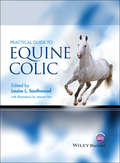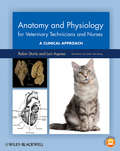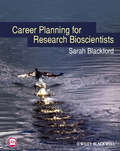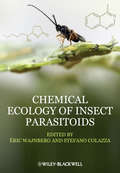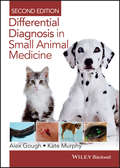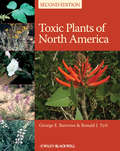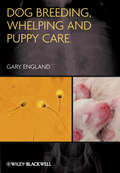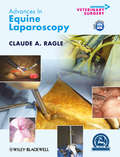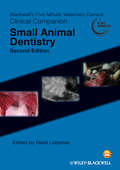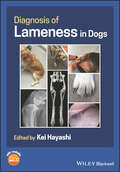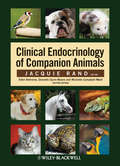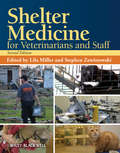- Table View
- List View
Practical Guide to Equine Colic
by Joanne FehrPractical Guide to Equine Colic takes a step-by-step clinical approach to the medical management of this common condition. Covering colic management and treatment from the veterinarian’s first involvement through referral, surgical intervention, and long-term recovery, the book offers practical advice on managing a colic case. Designed for easy navigation, chapters are brief and fully cross-referenced, allowing the reader to quickly find and apply information in the practice setting. The book incorporates key points, checklists, clinical tips, step-by-step illustrations, and case examples, emphasizing clinically relevant information throughout and referencing the most applicable and up-to-date literature. A companion website offers clinical cases, quizzes, and videos at www.wiley.com/go/southwood. Practical Guide to Equine Colic is an ideal resource for daily use in treating horses with colic, appealing to students, equine practitioners, and specialists alike.
Practical Guide to Equine Colic
by Joanne FehrPractical Guide to Equine Colic takes a step-by-step clinical approach to the medical management of this common condition. Covering colic management and treatment from the veterinarian’s first involvement through referral, surgical intervention, and long-term recovery, the book offers practical advice on managing a colic case. Designed for easy navigation, chapters are brief and fully cross-referenced, allowing the reader to quickly find and apply information in the practice setting. The book incorporates key points, checklists, clinical tips, step-by-step illustrations, and case examples, emphasizing clinically relevant information throughout and referencing the most applicable and up-to-date literature. A companion website offers clinical cases, quizzes, and videos at www.wiley.com/go/southwood. Practical Guide to Equine Colic is an ideal resource for daily use in treating horses with colic, appealing to students, equine practitioners, and specialists alike.
Anatomy and Physiology for Veterinary Technicians and Nurses: A Clinical Approach
by Robin Sturtz Lori AspreaAnatomy and Physiology for Veterinary Technicians and Nurses: A Clinical Approach is a comprehensive resource on the anatomy and physiology of dogs and cats, with comparisons to horses, birds, and ruminants. Organized by body system with a comparative approach, the book follows a unique format by addressing anatomy separately from physiology for clarity and improved comprehension. Each anatomy chapter has a corresponding physiology chapter, complete with illustrations, charts, and boxes to promote understanding. Written specifically for veterinary technicians and nurses, the book applies anatomy and physiology to clinical practice, with case examples demonstrating clinical relevance. The figures from the book, additional questions and answers, labeling quizzes, teaching PowerPoints, and a dissection video are available online at www.wiley.com/go/sturtz. This introduction to body system analysis of normal structure and function is a must-have resource for students of veterinary technology and nursing, as well as a useful quick review for the busy professional.
Anatomy and Physiology for Veterinary Technicians and Nurses: A Clinical Approach
by Robin Sturtz Lori AspreaAnatomy and Physiology for Veterinary Technicians and Nurses: A Clinical Approach is a comprehensive resource on the anatomy and physiology of dogs and cats, with comparisons to horses, birds, and ruminants. Organized by body system with a comparative approach, the book follows a unique format by addressing anatomy separately from physiology for clarity and improved comprehension. Each anatomy chapter has a corresponding physiology chapter, complete with illustrations, charts, and boxes to promote understanding. Written specifically for veterinary technicians and nurses, the book applies anatomy and physiology to clinical practice, with case examples demonstrating clinical relevance. The figures from the book, additional questions and answers, labeling quizzes, teaching PowerPoints, and a dissection video are available online at www.wiley.com/go/sturtz. This introduction to body system analysis of normal structure and function is a must-have resource for students of veterinary technology and nursing, as well as a useful quick review for the busy professional.
Career Planning for Research Bioscientists
by Sarah BlackfordCareer Planning for Research Bioscientists is an essential careers guide for bioscience doctoral students and postdoctoral researchers. It contains a wealth of information and resources specifically targeted at research bioscientists, with practical strategies to enhance career success in an increasingly competitive job market. Advice on how to write a winning CV together with examples adapted for different jobs is presented, as well as practical exercises to assist with skills analysis and decision making. Profiles of PhD-qualified bioscienstists in a range of professions including academic research, industry, science communication, management and consultancy provide valuable insights into how others have managed their careers, and tactics such as networking and using social media demonstrate how new opportunities can be discovered. The content of this book is aimed primarily at research bioscientists, however much of the advice and information will be a useful reference for other students and researchers looking for an effective career planning strategy. A companion website with additional resources is available at www.wiley.com/go/blackford/careerplanning and you can visit Sarah Blackford’s blog at www.biosciencecareers.org for more information.
Career Planning for Research Bioscientists
by Sarah BlackfordCareer Planning for Research Bioscientists is an essential careers guide for bioscience doctoral students and postdoctoral researchers. It contains a wealth of information and resources specifically targeted at research bioscientists, with practical strategies to enhance career success in an increasingly competitive job market. Advice on how to write a winning CV together with examples adapted for different jobs is presented, as well as practical exercises to assist with skills analysis and decision making. Profiles of PhD-qualified bioscienstists in a range of professions including academic research, industry, science communication, management and consultancy provide valuable insights into how others have managed their careers, and tactics such as networking and using social media demonstrate how new opportunities can be discovered. The content of this book is aimed primarily at research bioscientists, however much of the advice and information will be a useful reference for other students and researchers looking for an effective career planning strategy. A companion website with additional resources is available at www.wiley.com/go/blackford/careerplanning and you can visit Sarah Blackford’s blog at www.biosciencecareers.org for more information.
Chemical Ecology of Insect Parasitoids
by Eric WajnbergInsect parasitoids are a fascinating group of animals in many respects. Perhaps the most fascinating point is that these insects, in the course of the evolutionary time, have developed an impressive way to use chemical compounds to dialogue with the different protagonists of their environment (i.e., conspecifics, their hosts and the plants on which their hosts are living). Unravelling the evolutionary meaning of such chemical communication networks can give new insights into the ecology of these insects and especially on how to improve their use for the control of noxious pests in biological control programmes. Chemical Ecology of Insect Parasitoids is a timely publication, with organised chapters to present the most important knowledge and discoveries that have taken place over the last decade, and their potential use in pest control strategy. Specific relevant case studies are presented to enhance the reader's experience. Suited to graduate students and professional researchers and practitioners in pest management, entomology, evolutionary biology, behavioural ecology, and chemical ecology, this book is essential for anyone needing information on this important group of insects.
Chemical Ecology of Insect Parasitoids
by Eric Wajnberg Stefano ColazzaInsect parasitoids are a fascinating group of animals in many respects. Perhaps the most fascinating point is that these insects, in the course of the evolutionary time, have developed an impressive way to use chemical compounds to dialogue with the different protagonists of their environment (i.e., conspecifics, their hosts and the plants on which their hosts are living). Unravelling the evolutionary meaning of such chemical communication networks can give new insights into the ecology of these insects and especially on how to improve their use for the control of noxious pests in biological control programmes. Chemical Ecology of Insect Parasitoids is a timely publication, with organised chapters to present the most important knowledge and discoveries that have taken place over the last decade, and their potential use in pest control strategy. Specific relevant case studies are presented to enhance the reader's experience. Suited to graduate students and professional researchers and practitioners in pest management, entomology, evolutionary biology, behavioural ecology, and chemical ecology, this book is essential for anyone needing information on this important group of insects.
Small Animal ECGs: An Introductory Guide
by Mike MartinSmall Animal ECGs: An Introductory Guide provides all the information veterinarians need when using electrocardiography techniques for the first time. An ideal introduction to veterinary electrocardiography written in a very easy to understand way, for what can be a daunting subject The author is RCVS Recognised Specialist in Veterinary Cardiology and regularly speaks on this subject Full of examples of colour ECG tracings, as well as colour illustrations to explain arrhythmias Covers techniques that can readily be used in first opinion small animal practice Includes new chapters on mechanisms of supraventricular arrhythmias, accelerated idioventricular rhythm and use of Holters
Differential Diagnosis in Small Animal Medicine
by Alex Gough Kate MurphyA vital pocket-sized reference tool for busy practitioners and students, saving hours of searching through multiple sources. Differential Diagnosis in Small Animal Medicine, Second Edition brings together comprehensive differential diagnosis lists covering a wide range of presenting signs. This new edition has been fully updated with alphabetised lists for improved navigation. The lists cover the majority of presentations that are encountered in practice, including both common and uncommon conditions. Details differential diagnoses from diverse findings such as history, physical examination, diagnostic imaging, laboratory test results and electrodiagnostic testing Provides guidance on how common conditions are, and how commonly they are the cause of the presenting sign Useful throughout the working day for vets in small animal practice, the information will save hours searching alternative multiple references New co-author Kate Murphy brings her expertise as an ECVIM diplomate For ultimate ease of use this book is also available as an app for iOS and Android devices. To purchase the app visit www.skyscape.com/wiley/DDxSAMed2
Small Animal ECGs: An Introductory Guide
by Mike MartinSmall Animal ECGs: An Introductory Guide provides all the information veterinarians need when using electrocardiography techniques for the first time. An ideal introduction to veterinary electrocardiography written in a very easy to understand way, for what can be a daunting subject The author is RCVS Recognised Specialist in Veterinary Cardiology and regularly speaks on this subject Full of examples of colour ECG tracings, as well as colour illustrations to explain arrhythmias Covers techniques that can readily be used in first opinion small animal practice Includes new chapters on mechanisms of supraventricular arrhythmias, accelerated idioventricular rhythm and use of Holters
Differential Diagnosis in Small Animal Medicine
by Alex Gough Kate MurphyA vital pocket-sized reference tool for busy practitioners and students, saving hours of searching through multiple sources. Differential Diagnosis in Small Animal Medicine, Second Edition brings together comprehensive differential diagnosis lists covering a wide range of presenting signs. This new edition has been fully updated with alphabetised lists for improved navigation. The lists cover the majority of presentations that are encountered in practice, including both common and uncommon conditions. Details differential diagnoses from diverse findings such as history, physical examination, diagnostic imaging, laboratory test results and electrodiagnostic testing Provides guidance on how common conditions are, and how commonly they are the cause of the presenting sign Useful throughout the working day for vets in small animal practice, the information will save hours searching alternative multiple references New co-author Kate Murphy brings her expertise as an ECVIM diplomate For ultimate ease of use this book is also available as an app for iOS and Android devices. To purchase the app visit www.skyscape.com/wiley/DDxSAMed2
Toxic Plants of North America
by George E. Burrows Ronald J. TyrlToxic Plants of North America, Second Edition is an up-to-date, comprehensive reference for both wild and cultivated toxic plants on the North American continent. In addition to compiling and presenting information about the toxicology and classification of these plants published in the years since the appearance of the first edition, this edition significantly expands coverage of human and wildlife—both free-roaming and captive—intoxications and the roles of secondary compounds and fungal endophytes in plant intoxications. More than 2,700 new literature citations document identification of previously unknown toxicants, mechanisms of intoxication, additional reports of intoxication problems, and significant changes in the classification of plant families and genera and associated changes in plant nomenclature. Toxic Plants of North America, Second Edition is a comprehensive, essential resource for veterinarians, toxicologists, agricultural extension agents, animal scientists, and poison control professionals.
Toxic Plants of North America
by George E. Burrows Ronald J. TyrlToxic Plants of North America, Second Edition is an up-to-date, comprehensive reference for both wild and cultivated toxic plants on the North American continent. In addition to compiling and presenting information about the toxicology and classification of these plants published in the years since the appearance of the first edition, this edition significantly expands coverage of human and wildlife—both free-roaming and captive—intoxications and the roles of secondary compounds and fungal endophytes in plant intoxications. More than 2,700 new literature citations document identification of previously unknown toxicants, mechanisms of intoxication, additional reports of intoxication problems, and significant changes in the classification of plant families and genera and associated changes in plant nomenclature. Toxic Plants of North America, Second Edition is a comprehensive, essential resource for veterinarians, toxicologists, agricultural extension agents, animal scientists, and poison control professionals.
Dog Breeding, Whelping and Puppy Care
by Gary EnglandA practical and up-to-date guide to canine reproduction for dog breeders, veterinary students and veterinary surgeons. Written in an easy-to-use style and presented in a practically useful format with clear illustrations. The information is supported by references from the author’s published work and his wealth of clinical experience to form the important authoritative text in this field. A vital aid to those seeking an understanding of normal and abnormal reproduction as well as common reproductive techniques.
Advances in Equine Laparoscopy (AVS Advances in Veterinary Surgery)
by Claude A. RaglePart of the Advances in Veterinary Surgery series copublished with the ACVS Foundation and Wiley-Blackwell, Advances in Equine Laparoscopy presents a state-of-the-art reference on laparoscopic skills and procedures in the horse. Chapters are written by the leading experts in the field, and each section includes a practical review of the published literature. Encompassing instrumentation, basic principles, and specific techniques, Advances in Equine Laparoscopy offers an up-to-date, reliable resource for comprehensive information about equine laparoscopy. This current, well-referenced text begins with a section on the fundamentals of laparoscopy, then moves into sections on the clinical application of laparoscopic techniques in the standing or recumbent horse. A companion website offers eight video clips demonstrating selected procedures at www.wiley.com/go/ragle. Advances in Equine Laparoscopy is an invaluable guide for equine surgical specialists and equine clinicians interested in laparoscopic techniques.
Advances in Equine Laparoscopy (AVS Advances in Veterinary Surgery #3)
by Claude RaglePart of the Advances in Veterinary Surgery series copublished with the ACVS Foundation and Wiley-Blackwell, Advances in Equine Laparoscopy presents a state-of-the-art reference on laparoscopic skills and procedures in the horse. Chapters are written by the leading experts in the field, and each section includes a practical review of the published literature. Encompassing instrumentation, basic principles, and specific techniques, Advances in Equine Laparoscopy offers an up-to-date, reliable resource for comprehensive information about equine laparoscopy. This current, well-referenced text begins with a section on the fundamentals of laparoscopy, then moves into sections on the clinical application of laparoscopic techniques in the standing or recumbent horse. A companion website offers eight video clips demonstrating selected procedures at www.wiley.com/go/ragle. Advances in Equine Laparoscopy is an invaluable guide for equine surgical specialists and equine clinicians interested in laparoscopic techniques.
Blackwell's Five-Minute Veterinary Consult Clinical Companion: Small Animal Dentistry (Blackwell's Five-Minute Veterinary Consult)
by Heidi B. LobpriseBlackwell’s Five-Minute Veterinary Consult Clinical Companion: Small Animal Dentistry, Second Edition presents essential information in a succinct, well-defined format for easy and quick access. This fully revised edition offers more color images, general updates from recent developments, and extensive revisions to the diagnostic and techniques sections, as well as additional information on charting with corresponding illustrations. New topics include exotic pets, including ferrets, prairie dogs, and chinchillas; oral pain management; home care; the technician in dentistry; and the business of dentistry. Topics cover diagnostics and treatment in a logical step-wise fashion, taking the typical Five-Minute format. Ancillary subjects on pain management, home care, and small mammal care have also been addressed and expanded, and a new companion website offers client education handouts to download and use in practice at www.wiley.com/go/lobprise. Blackwell’s Five-Minute Veterinary Consult Clinical Companion: Small Animal Dentistry is the ideal practical manual for general practitioners seeking accessible, reliable information on dentistry techniques and treatments.
Blackwell's Five-Minute Veterinary Consult Clinical Companion: Small Animal Dentistry (Blackwell's Five-Minute Veterinary Consult #2)
by Heidi B. LobpriseBlackwell’s Five-Minute Veterinary Consult Clinical Companion: Small Animal Dentistry, Second Edition presents essential information in a succinct, well-defined format for easy and quick access. This fully revised edition offers more color images, general updates from recent developments, and extensive revisions to the diagnostic and techniques sections, as well as additional information on charting with corresponding illustrations. New topics include exotic pets, including ferrets, prairie dogs, and chinchillas; oral pain management; home care; the technician in dentistry; and the business of dentistry. Topics cover diagnostics and treatment in a logical step-wise fashion, taking the typical Five-Minute format. Ancillary subjects on pain management, home care, and small mammal care have also been addressed and expanded, and a new companion website offers client education handouts to download and use in practice at www.wiley.com/go/lobprise. Blackwell’s Five-Minute Veterinary Consult Clinical Companion: Small Animal Dentistry is the ideal practical manual for general practitioners seeking accessible, reliable information on dentistry techniques and treatments.
Diagnosis of Lameness in Dogs
by Kei HayashiDiagnosis of Lameness in Dogs Accessible and easy-to-understand step-by-step guide to the diagnosis of lameness in dogs Diagnosis of Lameness in Dogs provides general practice vets with a practical, step-by-step guide to performing the orthopedic diagnostic exam, including basic diagnostic imaging and advanced techniques such as CT, MRI, ultrasound, and arthroscopy, and arriving at a correct diagnosis. Treatment options are briefly summarized with the focus of the book being on diagnostics – because general practitioners will generally refer lameness cases. This book therefore provides guidance on possible causes of lameness and when to refer, and perhaps more critically, when not to refer. Overall, the text enables general practice veterinarians and veterinary students to develop confidence in accurately diagnosing causes of lameness. More than 600 color images depicting the procedures are included throughout the text. A companion website provides video clips of specific lameness conditions to aid in reader comprehension and information retention. Written by well-known orthopedic surgeons working in the area of lameness, Diagnosis of Lameness in Dogs also includes information on: General examinations, providing a systematic approach to the examination ensures that multiple problems are not missed Immediate steps to provide urgent care to severely traumatized dogs with hemorrhaging wounds and unstable/open fractures Systemic conditions, neurological disorders, and oncologic diseases that need to be ruled out before arriving at a diagnosis of the problem Specific conditions and diagnostic procedures for the thoracic limb, including bone disease, carpal/distal joints, the elbow joint, and the shoulder joint Specific conditions and diagnostic procedures for the pelvic limb, including bone disease, tarsal/distal joints, the stifle joint, and the hipar joint The first book to cover lameness diagnosis in detail, Diagnosis of Lameness in Dogs is a highly useful resource for veterinarians and students interested in improving their orthopedic diagnostic skills through gaining a foundation of relevant knowledge and an understanding of how to apply this knowledge in a field setting.
Diagnosis of Lameness in Dogs
by Kei HayashiDiagnosis of Lameness in Dogs Accessible and easy-to-understand step-by-step guide to the diagnosis of lameness in dogs Diagnosis of Lameness in Dogs provides general practice vets with a practical, step-by-step guide to performing the orthopedic diagnostic exam, including basic diagnostic imaging and advanced techniques such as CT, MRI, ultrasound, and arthroscopy, and arriving at a correct diagnosis. Treatment options are briefly summarized with the focus of the book being on diagnostics – because general practitioners will generally refer lameness cases. This book therefore provides guidance on possible causes of lameness and when to refer, and perhaps more critically, when not to refer. Overall, the text enables general practice veterinarians and veterinary students to develop confidence in accurately diagnosing causes of lameness. More than 600 color images depicting the procedures are included throughout the text. A companion website provides video clips of specific lameness conditions to aid in reader comprehension and information retention. Written by well-known orthopedic surgeons working in the area of lameness, Diagnosis of Lameness in Dogs also includes information on: General examinations, providing a systematic approach to the examination ensures that multiple problems are not missed Immediate steps to provide urgent care to severely traumatized dogs with hemorrhaging wounds and unstable/open fractures Systemic conditions, neurological disorders, and oncologic diseases that need to be ruled out before arriving at a diagnosis of the problem Specific conditions and diagnostic procedures for the thoracic limb, including bone disease, carpal/distal joints, the elbow joint, and the shoulder joint Specific conditions and diagnostic procedures for the pelvic limb, including bone disease, tarsal/distal joints, the stifle joint, and the hipar joint The first book to cover lameness diagnosis in detail, Diagnosis of Lameness in Dogs is a highly useful resource for veterinarians and students interested in improving their orthopedic diagnostic skills through gaining a foundation of relevant knowledge and an understanding of how to apply this knowledge in a field setting.
Clinical Endocrinology of Companion Animals
by Jacquie Rand Ellen Behrend Danielle Gunn-Moore Michelle Campbell-Ward Danièlle Gunn-MooreClinical Endocrinology of Companion Animals offers fast access to clinically relevant information on managing the patient with endocrine disease. Written by leading experts in veterinary endocrinology, each chapter takes the same structure to aid in the rapid retrieval of information, offering information on pathogenesis, signalment, clinical signs, diagnosis, differential diagnosis, treatment, prognosis, and prevention for a broad list of endocrine disorders. Chapters begin with brief summaries for quick reference, then delve into greater detail. With complete coverage of the most common endocrine diseases, the book includes chapters on conditions in dogs, cats, horses, ferrets, reptiles, and other species. Clinical Endocrinology of Companion Animals is a highly practical resource for any veterinarian treating these common diseases.
Clinical Endocrinology of Companion Animals
by Jacquie RandClinical Endocrinology of Companion Animals offers fast access to clinically relevant information on managing the patient with endocrine disease. Written by leading experts in veterinary endocrinology, each chapter takes the same structure to aid in the rapid retrieval of information, offering information on pathogenesis, signalment, clinical signs, diagnosis, differential diagnosis, treatment, prognosis, and prevention for a broad list of endocrine disorders. Chapters begin with brief summaries for quick reference, then delve into greater detail. With complete coverage of the most common endocrine diseases, the book includes chapters on conditions in dogs, cats, horses, ferrets, reptiles, and other species. Clinical Endocrinology of Companion Animals is a highly practical resource for any veterinarian treating these common diseases.
Shelter Medicine for Veterinarians and Staff
by Lila Miller Stephen ZawistowskiShelter Medicine for Veterinarians and Staff, Second Edition is the premier reference on shelter medicine. Divided into sections on management, species-specific animal husbandry, infectious disease, animal cruelty, shelter programs, behavior, and spay/neuter, the new edition has been reformatted in a more user-friendly design with briefer chapters and information cross-referenced between chapters. Maintaining a herd health approach, new and expanded chapters address issues of husbandry, infectious disease management, behavior forensics, population management, forensic toxicology, animal cruelty and hoarding, enrichment in shelters, spay/neuter, and shelter design. Now in full color, this fully updated new edition delivers a vast array of knowledge necessary to provide appropriate and humane care for shelter animals. Veterinarians, veterinary technicians and shelter professionals will find this to be the go-to resource on the unique aspects of shelter medicine that help facilitate operating a modern, efficient, and humane shelter.
Shelter Medicine for Veterinarians and Staff
by Lila Miller Stephen ZawistowskiShelter Medicine for Veterinarians and Staff, Second Edition is the premier reference on shelter medicine. Divided into sections on management, species-specific animal husbandry, infectious disease, animal cruelty, shelter programs, behavior, and spay/neuter, the new edition has been reformatted in a more user-friendly design with briefer chapters and information cross-referenced between chapters. Maintaining a herd health approach, new and expanded chapters address issues of husbandry, infectious disease management, behavior forensics, population management, forensic toxicology, animal cruelty and hoarding, enrichment in shelters, spay/neuter, and shelter design. Now in full color, this fully updated new edition delivers a vast array of knowledge necessary to provide appropriate and humane care for shelter animals. Veterinarians, veterinary technicians and shelter professionals will find this to be the go-to resource on the unique aspects of shelter medicine that help facilitate operating a modern, efficient, and humane shelter.
